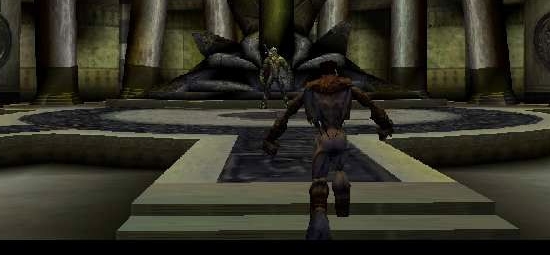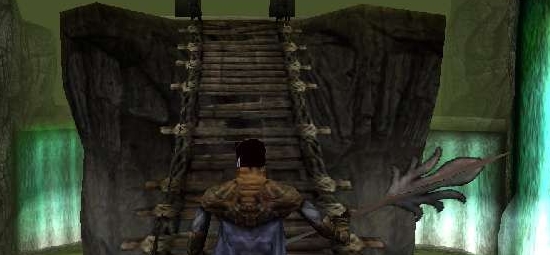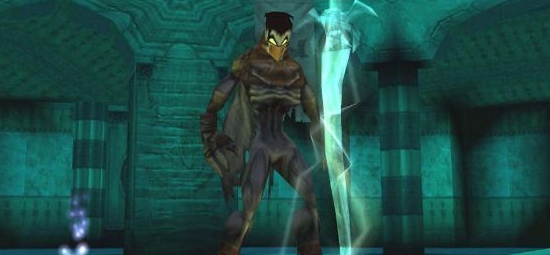PlayStation Classics Corner is a new series on PSLS dedicated to modern reviews of PlayStation Classics released on PSN.
“Like a corpse in a shallow grave, corruption rises to the surface.”
About the game:
Soul Reaver is a 1999 action-adventure game from Crystal Dynamics, published by Eidos.
The Legacy of Kain: Soul Reaver is a sequel to the game The Legacy of Kain: Blood Omen. While Blood Omen is 2D, Soul Reaver made the leap to 3D, a perspective all subsequent Legacy of Kain titles accepted.
Like many other PS1 titles, Soul Reaver begins with a CG cutscene. When Raziel, one of the lead Lieutenants of the vampire lord Kain, develops wings, he presents this development to Kain. In jealousy and fear of a potential coup, Kain tears the bone from Raziel’s wings and orders him cast into The Abyss, a whirlpool in the Lake of the Dead used to execute weak vampires or traitors. Raziel wakes up 500 years later as a wraith, and sets out on a quest to avenge his own death, aided by the Elder God – voiced masterfully by the late Tony Jay. This is merely a starting point to a plot with many twists and turns, but I won’t spoil any more.

Partly written, designed and produced by Amy Hennig, currently the lead writer and creative director of the Uncharted series, Soul Reaver is a good example of why Naughty Dog wanted her on board so badly – Soul Reaver‘s narrative focus is on character and plot development, and the dialog and voice acting are some of the best the game industry has to offer. Voices suit the characters perfectly, line delivery is top-notch and conversations feel natural but have real immediacy to them. Hearing mortal enemies threaten one another with such great vocabularies and verbal complexity before a fight to the death just feels so right.
Soul Reaver‘s gameplay takes some cues from the 3D Zelda titles: it is a 3D action-adventure game with multiple “dungeon” levels, a focus on puzzles and hack-and-slash combat. There are two dimensions to the game, the spectral realm and the physical realm. The spectral realm can be entered at any time, but players must find transition points scattered generously throughout the levels to return to the physical realm. In the physical realm players slowly lose health, and when it runs out they’re thrown into the spectral realm; to restore health, players must absorb the souls of their fallen enemies.
Unfortunately, Soul Reaver‘s combat is really lacking. Raziel can attack with his hands, weapons he picks up and a certain energy blade players acquire a few hours into their journey, but it just feels really bulky, unintuitive and frustrating most of the time. Getting attacks to connect with foes takes more effort than it should a lot of the time and it’s mostly one-dimensional, outside of having to sidestep to avoid an attack every once in a while. The game’s camera is rotated by L2/R2, so playing this on the PSP or Vita can feel awkward at times – home consoles are the optimal way to experience this game.
Luckily, combat isn’t the focus of the game, puzzle-solving is. Many of the puzzles involve moving blocks around, and the blocks can be flipped over – either to get the faces into the correct positions or to move the block up stairs. Sometimes puzzles involve moving certain items into the right position, other times they involve entering the spectral realm to change some small feature in the world, occasionally players must use lateral thinking to figure out some order tasks must be carried out.

The game’s puzzles rarely become more complex than those of the 3D Zelda games, but they are made more obtuse and confusing by two massive flaws: there are no maps in Soul Reaver, and the directions players are given are wildly inadequate. It is very easy to get lost in Soul Reaver, running around in circles, back-tracking and losing hope just because the instructions are poor, if not borderline non-existent. I normally try to avoid guides while playing through games for reviews, but I consider them an absolute necessity for this game. Find a good video walkthrough series or a guide with accompanying screenshots online and expect to put them to good use to get through some of the game’s more devious puzzles and to be set right on your path.
There’s quite a bit more to love about Soul Reaver than its story, writing and dialog, which are, by the way, supported by a moody, ambient soundtrack that sets the tone of the game perfectly. Soul Reaver makes an absolutely stunning use of the PS1’s hardware, with no load times after the game initially starts up and some of the greatest visuals I’ve ever seen on the PS1. Soul Reaver truly rivals or surpasses Tomb Raider III, Syphon Filter 3 and even Metal Gear Solid visually, with a great art style, wonderful environments and some very nice special effects (the spectral dimension effects deserve special mention). I’m genuinely floored with what they were able to do with the limited hardware they had to work with, but draw distances are admittedly pretty limited, so expect that to be a bit of a nuisance.
It takes a lot of work to see Soul Reaver to the end, so I recommend a guide to anyone who doesn’t want to be stuck for hours, figuring out some block puzzle or where to go next. The storytelling is great payoff, but it’s up to you to decide if that makes up for the awkward combat mechanics and the constant feeling of confusion, of being lost without a map.
[Images]
-
Spectacular writing, voice acting, direction and sound design
-
Some of the best visuals on the PS1
-
No load times
-
Awkward combat and platforming
-
No maps, insufficient instructions
-
"I have no idea where to go next."
-
"Alright, I solved the puzzle! ...now I'm lost again."








